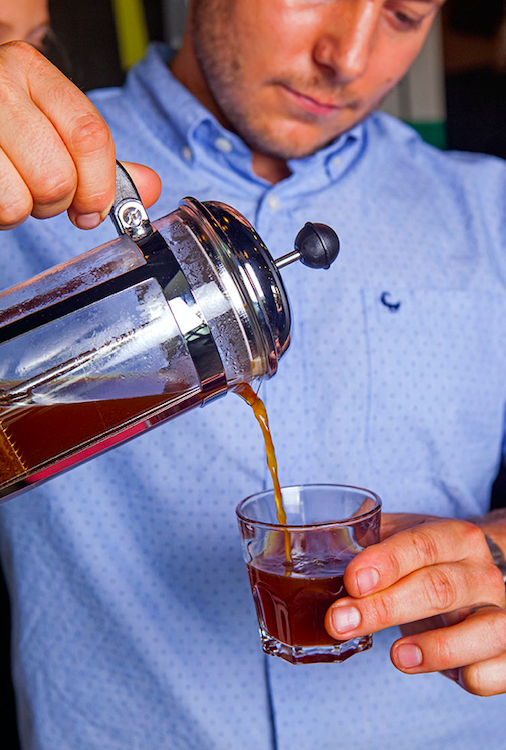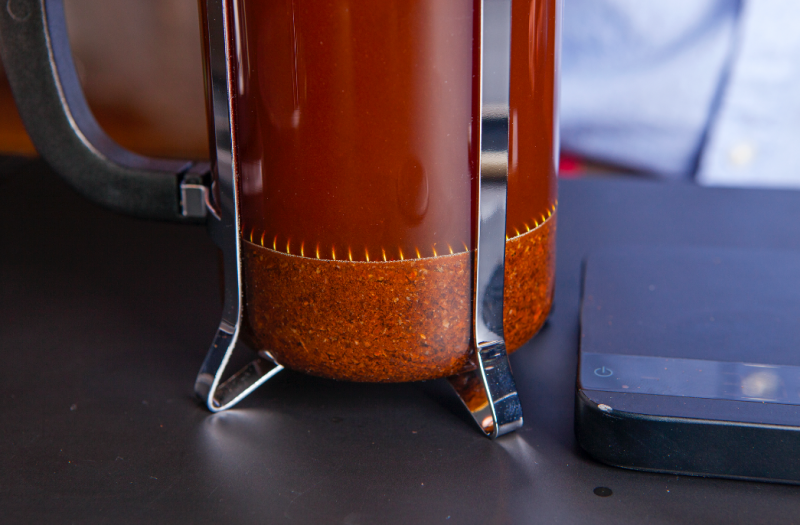Words by Craig Charity
Photography by Jon Ivins
Plunger coffee. Seems old-fashioned? Craig Charity, 2013 SA Barista Champion, is here to change your mind. You might just rediscover the simple beauty of the French Press.
The thing that I love about the plunger is that it is really accessible to everyone. Almost every household has at least one and they are pretty easy to use, but most people ignore simple things that can take this tool from making ok coffee to incredible coffee. Let me enlighten you.
I always find that the simpler the contraption the more I use it. If a coffee brewer makes incredible coffee but becomes a mission to use I will use it on occasion but will generally go back to methods that are easier, in most instances that is the humble plunger. The plunger is like cupping without the spoon.

Paper vs metal filters
Paper filters used in method like Chemex or V60 retain the oils of the coffee in the filter and you end up with a beautiful tea-like coffee. The mouth-feel is light and silky because all the coffee fines are trapped behind with the filter paper. Is that a good thing? I don't think so, I just think it is a different way of brewing coffee and boils down (no pun intended…yet) to personal taste, coffee and the occasion.
Metal filters allow the coffee oils and coffee fines (really fine coffee grinds) to end up in your cup ending up with a coffee that has a musky and full-bodied mouth-feel.
Fully submerged vs pour over
Fully submerged methods like Siphon, Plunger and the Clever Coffee Dripper allow the coffee grounds to be completely surrounded by water and, in my humble opinion, are easier to use to get a consistent result. One big and important variable is in your control when making full immersion methods: Time. You can stop the extraction at any point in a plunger.
How to make a better plunger coffee
Areas in your control are the following:
Grind size, time and temperature
I have lumped these three variables together because they are the ones predominantly responsible for changes in taste. Without going into the chemistry of it, grind size, time of extraction and temperature of the water affect coffee extraction because different compounds of the coffee get extracted at different temperatures and at different times. The size of your ground coffee will determine how quickly it extracts. With the plunger, if too fine it extracts too quickly which results in a very bitter coffee (and one that you have to use a knife and fork to drink). Too coarse and it will take too long to extract and you will have a coffee that is under-extracted and erring on the sour and salty side of the spectrum.

Grind size is the thing that I would play with the most. I generally keep my time, temperature and ratio the same and use grind size to alter the taste of the coffee. On this note, it is imperative that you are using a good burr grinder. By a good burr grinder I mean one that does not say ‘coffee and spice grinder’ on the side of the box or one that comes as an attachment to your blender/mixer at home. There are some great hand grinder options and the Severin electric one is great for home filter brews. For plungers use a grind size that is slightly bigger than the holes in the mesh of the plunger, unless you like eating your coffee.
Time is on your side with fully submerged methods. You can cut your extraction at whatever time you want. If you cannot change the grind size you can try and compensate by steeping it for longer to aid extraction and visa versa. Keep this at a constant of around three and a half minutes.
Temperature does a similar thing, the hotter the water the quicker the coffee will extract, the cooler it is the slower it will extract(some compounds will only extract at higher temperatures but I generally don't like the taste of coffee extracted at temperatures above 96 degrees celsius.
Ratio of coffee to water
Find a ratio of coffee and water that you like, this will determine the strength of your coffee. Obviously more coffee and less water (with the same time, temperature and grind size) will result in a stronger coffee.
The ratio I generally use is about 1:15, which is 1g of coffee to 15g of water. In most cases I use 42g of coffee -because 42 is the answer to the universe- and 630g of water and let it steep for between three and a half to four minutes in water that has been off the boil for about one and a half minutes (+-94 degrees Celsius).

Clean equipment
You cannot make a good coffee with a dirty plunger. If your coffee plunger smells like anything other than glass and metal you need to clean it better. I dismantle my plunger after use and put it in the dishwasher. If you don't you will still be getting that incredible coffee that you tasted a long time ago that is now stale, rancid and void of any goodness showing up in your cup. For plungers like the Espro Press that have a very fine mesh I find the best way to clean it is to soak it in espresso machine detergent and boiling water which takes out the rancid coffee oils.
Oh, one more thing. The coffee that you drink will only be as good as the sum of its two parts, water and coffee. If you are not using good quality filtered water and freshly roasted quality coffee you will be disappointed in the result. I know this might sound like a mission, but once you have found a recipe that works for you it is a really simple task and one that can produce consistently, incredible coffee. You’ll never look back!
There you have it, now go and dust off that plunger and start using it!